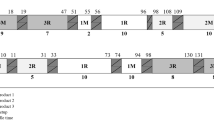Abstract
The aim of this paper is to propose an mixed integer linear programming (MILP) model for operations lot-sizing and scheduling (assignment and sequencing) in the supply chain of an international company which produces and delivers customized products through several geographically distributed assembly plants. The model schedules the purchase of raw materials in the various plants considered, the transshipments, shipments to customers and the various operations to assemble the product. The model considers different alternative production operations such as product substitution (upgrading), alternative procurement and transport operations. It also addresses the different lead times associated with these operations. Specific constraints such as space availability on each plant and workforces are contemplated. A novel approach based on the stroke concept is applied to the MILP model to model alternatives.
Access this chapter
Tax calculation will be finalised at checkout
Purchases are for personal use only
Similar content being viewed by others
References
Garcia-Sabater JP, Maheut J, Garcia-Sabater JJ (2009a) A capacited material requierements planning model considering delivery constraints. In: 3rd international conference on industrial engineering and industrial management. pp 793–803
Garcia-Sabater JP, Maheut J, Garcia-Sabater JJ (2009b) A capacited material requierements planning model considering delivery constraints: a case study from the automotive industry. In: 39th international conference on computers and industrial engineering. pp 378–383
Graves SC, Willems SP (2003) Supply chain design: safety stock placement and supply chain configuration. Handb Oper Res Manag Sci 11:95–132
Haase K (1996) Capacitated lot-sizing with sequence dependent setup costs. OR Spectr 18:51–59
Hnaien F, Dolgui A, Louly MA (2008) Planned lead time optimization in material requirement planning environment for multilevel production systems. J Syst Sci Sys Eng 17:132–155
Karimi B, Fatemi Ghomi SMT, Wilson JM (2003) The capacitated lot sizing problem: a review of models and algorithms. Omega-Int J Manage S 31:365–378
Lang JC (2010) Production and inventory management with substitutions. Springer, Germany
Li H, Womer K (2008) Modeling the supply chain configuration problem with resource constraints. Int J Proj Manag 26:646–654
Lloret J, Garcia-Sabater JP, Marin-Garcia J (2008) Cooperative multisite production re-scheduling
Mohammadi Bidhandi H, Yusuff R, Megat Ahmad MMH et al (2009) Development of a new approach for deterministic supply chain network design. Eur J Oper Res 198:121–128
Mula J, Maheut J, Garcia-Sabater JP (2011) Mathematical modelling for supply chain configuration. In: Brennan. Christopher R (ed) Mathematical modelling. Nova Science Publisher, New York
Nagurney A (2010) Optimal supply chain network design and redesign at minimal total cost and with demand satisfaction. Int J Prod Econ 128:200–208
Pantelides CC (1994) Unified frameworks for the optimal process planning and scheduling. In: Proceedings of the 2nd Conference on the Foundations of Computer Aided Operations. 253–274
Stadtler H (2005) Supply chain management and advanced planning–basics, overview and challenges. Eur J Oper Res 163:575–588
Tempelmeier H, Buschkühl L (2008) Dynamic multi-machine lotsizing and sequencing with simultaneous scheduling of a common setup resource. Int J Prod Econ 113:401–412
Wagner HM, Whitin TM (1958) Dynamic version of the economic lot size problem. Manage Sci 5:89–96
Acknowledgments
The research leading to these results has received funding from the European Community’s Seventh Framework Programme (FP7/2007-2013) under grant agreement no. NMP2-SL-2009- 229333. Julien Maheut holds a Val I+D grant funded by the Generalitad Valenciana (Regional Valencian Government, Spain) (Ref. ACIF/2010).
Author information
Authors and Affiliations
Corresponding author
Editor information
Editors and Affiliations
Rights and permissions
Copyright information
© 2012 Springer-Verlag London Limited
About this paper
Cite this paper
Maheut, J., Garcia-Sabater, J.P., Mula, J. (2012). A Supply Chain Operations Lot-Sizing and Scheduling Model with Alternative Operations. In: Sethi, S., Bogataj, M., Ros-McDonnell, L. (eds) Industrial Engineering: Innovative Networks. Springer, London. https://doi.org/10.1007/978-1-4471-2321-7_35
Download citation
DOI: https://doi.org/10.1007/978-1-4471-2321-7_35
Published:
Publisher Name: Springer, London
Print ISBN: 978-1-4471-2320-0
Online ISBN: 978-1-4471-2321-7
eBook Packages: EngineeringEngineering (R0)




